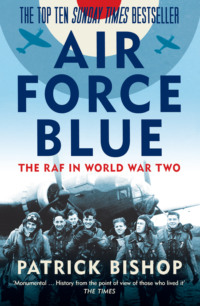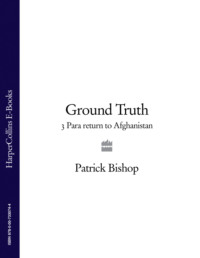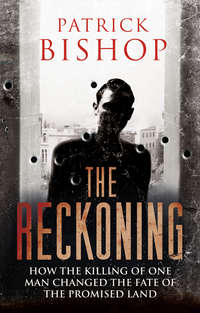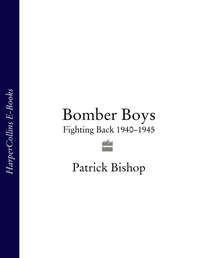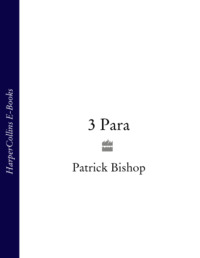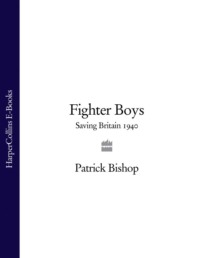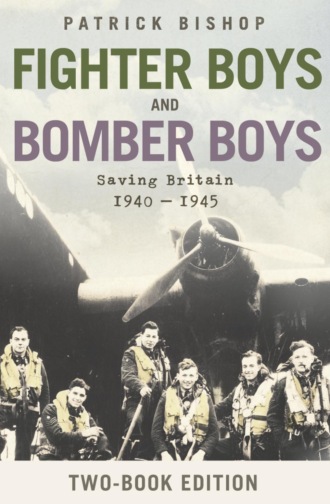
Полная версия
Fighter Boys and Bomber Boys: Saving Britain 1940-1945
Life was not so congenial at every fighter base. Conditions around the country were variable. The fast rate of the expansion meant accommodation often lagged behind needs. Desmond Sheen, a nineteen-year-old Australian who joined the RAF on a short-service commission from the Royal Australian Air Force, arrived at 72 Squadron at Church Fenton in Yorkshire in June 1937 to be told he was living in a tent at the end of the airfield while the mess was being built. ‘We stayed there until November when the fog and the mists drove us out and we moved into hangars until the building was completed.’31 When Arthur Banham reported for duty to 19 Squadron at Duxford in Cambridgeshire after finishing his training in August 1936, he was put with nine other junior officers in a hut which acted as a dormitory. ‘The whole place was a mess, with trenches all over the place where they were laying foundations for the new buildings. The officers married quarters weren’t built and most officers lived out of the aerodrome altogether.’32
Arriving at their first posts, the newly qualified pilots learned quickly that henceforth everything would centre on the squadron. It became the focus of their professional and their social lives. Nothing could be more exciting than flying and no one could be more fun to be with than one’s fellow fighter pilots. ‘It was a wonderful time for most of us,’ remembered John Nicholas, who joined 65 Squadron in December 1937. ‘It was very pleasant to be with a number of young men of one’s own age, most of whom believed in the same things.’33 Some of the pre-expansion pilots had worried that the influx would dilute the clubby character of the old organization and dissolve its tenderly guarded esprit de corps. Peter Townsend, a sensitive, reflective career officer who had passed out of Cranwell as the Prize Cadet, returned to Britain to join 43 Squadron in June 1937 after a posting to the Far Bast, to find that ‘gone were the halcyon days of “the best flying club in the world” Tangmere was now peopled by strange faces, different people with a different style. I resented the new generation of pilots who had answered the RAF’s urgent appeal and found heaven-sent relief from boring civilian jobs.’34 Townsend accepted, almost immediately, that these feelings were unworthy. In a subsequent mea culpa he admitted that ‘my prejudices against them were ignoble, for they were soon to become the most generous-hearted friends, then, a little later, die, most of them, for England’. The reasoning was, anyway, wrong. At any time in the years before the run-up to the expansion programme, a majority of officers in the admittedly much smaller RAF were serving on short-service commissions.
The newcomers took to the existing traditions quickly, offering no serious challenge to the way things were done. Many were familiar with the routines of sport, joviality and boisterous high spirits from school days. Most of the short-service commission pilots entering in the expansion years had a public-school background of one sort or another. Roland Beamont was at Eastbourne College, Geoffrey Page at Dean Close, Cheltenham, Paddy Barthropp went to Ampleforth and Arthur Banham to the Perse School, Cambridge. Bob Tuck attended a small fee-paying day school, St Dunstan’s at Catford, and Pete Brothers a similar establishment, North Manchester School. Billy Drake, James Saunders and John Nicholas were educated abroad. Pat Hancock went to a day school in Croydon before moving to the technical college. Dennis David had been to a boarding school in Deal before changing to Surbiton County School. Of the Cranwellians, Tim Vigors had been at Eton and Brian Kingcome at Bedford.
Most of the entrants, even if they had not been to a proper public school, knew something of the ethos, if only from the pages of the Magnet and the Gem. Bob Doe, a secondary-school boy, felt out of place. Of his fellow short-service entrants he was ‘probably the poorest of the lot. I hadn’t done all the things other people had done. I felt very much an outsider. I was very shy as well, which didn’t help. They were friendly enough but I always felt I was inferior.’35 The barriers were lowered when he was invited to club together with three others to buy a Hispano-Suiza saloon for £20, this enabling them to go on occasional forays into Cheltenham, twelve miles from Little Rissington, where they were based.
The overseas entrants had little difficulty fitting in. Their status as colonials put them beyond the rigid categorizations of the British class system. Desmond Sheen’s father was a plasterer, but he found at 72 Squadron that ‘everyone got on, with a lot of hilarity and a lot of fun, extremely well. There was no conflict. There was a lot of taking the mickey out of each other, but it was all very friendly. They were all good sports.’36
Being a good sport was the essential quality in fitting in. Taken literally, it meant that athletic ability would count in a pilot’s favour, a factor which benefited the outdoorsy arrivals from the Empire. Deere found that ‘the natural reserve of all Englishmen gave way to a more friendly approach’ after a game of rugby in which New Zealanders took on the rest, beating the English pilots by a colossal score. He was a boxer who had taken part in the New Zealand amateur championships. He was reluctant to don the gloves again, but was persuaded to do so by a senior officer who advised him it would be good for his career. The abbreviation of a first name, the bestowal of a nickname, signalled you were in. Alan quickly became Al.
Being a good sport, however, went beyond the observance of the conventions, attitudes and observances of middle-class males of the time. A mood of tolerance prevailed so that individuality, even eccentricity, was prized. The business of aerial warfare meant that the type of military discipline applied to soldiers and sailors was not appropriate for airmen. Junior officers addressed their squadron superiors as ‘sir’ on the initial meeting of the day. After that it was first names. Once in combat in the air, everyone was essentially on their own and beyond the orders of a commander. Good pilots, anyway, succeeded by initiative and making their own decisions.
From the earliest days on the Western Front, pilots took a relaxed view of military conventions and often displayed a sceptical attitude towards senior officers, though seldom with their own immediate commanders if they had earned their respect. Pomposity was ruthlessly punished and shyness discouraged. Coy newcomers learned that a certain amount of leg-pulling and practical joking was the price of belonging. Deere, like all new arrivals, spent his first few weeks at 54 Squadron at Hornchurch doing dogsbody tasks like overseeing the pay and clothing parades. He was also required to check the navigation inventory and found to his concern that an item called the Oxometer was missing. On informing his flight commander, he was told that this was a very serious matter and the station commander might have to be notified if it was not found. It was some days before he ‘realized that no such item of equipment existed and that it was a trick played on all new pilots and one in which everyone from the station commander down participated’.37 The joke took on a further refinement when a particularly earnest pilot officer was told that the missing Oxometer had been found. A fake instrument was rigged up and the relieved officer invited to blow in it to check it was working, which resulted in him being sprayed with soot.
The boisterous and extrovert tone of squadron life disguised a level of consideration and fellow feeling that perhaps marked out the RAF from the other services. The testimony of survivors, and what little was written down by those who died, is imbued with an overwhelming affection for fellow pilots and for the units in which they served. The camaraderie that came with membership of a fighter squadron appears to have provided a degree of spiritual sustenance, augmenting the warmth of an absent family or making those with dislocated backgrounds feel they had arrived at a place where they belonged. The simple cheeriness that was the Fighter Boys’ chosen style masked some complicated stories. Geoffrey Page’s parents were separated. His father frightened him and he resented his miserly attitude toward his mother. Dennis David was brought up by his mother after his father, who drank and had financial troubles, abandoned the family when he was eight. Brian Kingcome’s mother had returned to England with her children, leaving her husband to continue working in India. He returned only once every two and a half years. As Kingcome was at boarding school, he barely saw his son during his childhood and adolescence.
The modern assumption is that such experiences must leave a mark. Feeling sorry for oneself lay outside the range of emotions allowed to adolescents in Britain in the 1930s. Kingcome admired and respected his largely absent father. Paddy Barthropp’s mother died in childbirth, a tragedy that meant his father ‘resented my very existence almost up to the time of his own death in 1953. I never blamed him.’ At Ampleforth one day in 1936 ‘a school bully approached me to say that it would be a good idea if I read page four of The Times in the school library. There it was for all to see – “In the High Court of Bankruptcy, Elton Peter Maxwell D’Arley Barthropp”…the fact that one was skint was not acceptable and carried a long-lasting social stigma…the next few days were the most embarrassing of my life.’ He was farmed out to a step-grandfather, ‘extremely rich and very nasty’, among whose many possessions was the Gresford Colliery near Wrexham. On hearing that there had been a disaster at the mine killing 264 miners, the old man ‘replied that he didn’t want to be disturbed. He disgusted me.’38 Barthropp eventually got an apprenticeship with Rover Cars in Coventry before deciding to join the RAF after a visit to the Hendon Air Display.
Barthropp was hopeless academically. He failed the school certificate five times, and only scraped through his RAF board by gaining ‘a phoney pass’ from a crammer. Roland Beamont also failed his school certificate and had to resort to coaching to get the qualification he needed to be eligible for a short-service commission. Denys Gillam, who joined the RAF on a short-service commission in 1935, had been kicked out of his prep school, then his public school, Wrekin College, for drinking and exam irregularities. He later joined 616 Squadron and commanded two fighter squadrons. Against the wisdom of the pre-war days his preferred pilots were ‘non-athletic men between the ages of eighteen to twenty-three’, who had ‘better resilience to stress than the successful rugger player or his equivalent…all the best pilots that I knew tended to be rather weedy, though there were exceptions. The best pilot were ones that hadn’t had much success in other spheres and were determined to succeed.’ Teaching a course to a class of wing commanders later in his career, he discovered that ‘out of a group of twelve…four had been thrown out of their school before they left. This was, I think, fairly typical.’39 Kingcome was to deliver the opinion later that, ‘Fortunately for us, and, I believe, for the RAF in that generation, there were [no]…psychological and aptitude tests, which would have failed a majority of candidates for short-service and permanent commissions and I suspect might have cost us the Battle of Britain.’40
Expansion increased the flow of men from the lower reaches of the RAF into the ranks of the fliers as candidates were selected from among the ground crews to serve as sergeant pilots. Of the 2,500 pilots originally sought to man the new aircraft and squadrons, 800 were found from among those already serving as aircraftmen or non-commissioned officers. The RAF apprentice schemes allowed a trickle of fitters, riggers and other tradesmen to receive flying training, on the understanding that they would return to their trades after five years. There were also two places set aside for the top performers at Halton to go on to Cranwell to take up a cadetship. Many, perhaps most, apprentices had dreams of flying. Realizing them was difficult. There was an obvious necessity to maintain the supply of highly skilled, expensively trained ground staff to keep the service flying and prevent apprenticeships from turning into a back-door route to a career as a pilot. None the less, in the pre-expansion years, some of the keenest and most talented felt themselves baulked by what was supposed to be a system that worked on merit. George Unwin was brought up in South Yorkshire, where his father was a miner. His mother encouraged his education and he won a scholarship to Wath Grammar School, and aged sixteen passed his Northern Universities matriculation exam. There was no money for him to take up a place. The only work on offer was down the pit. When, a month before he was due to leave, his headmaster showed him an RAF recruiting pamphlet, he decided to join up.
Unwin chose the Ruislip administrative apprentice school rather than the technical school at Halton, as the course there was two rather than three years. It was a spartan life. The food was horrible. They seemed to live on gristly mutton rissoles, and food parcels from the outside world were eagerly received. They shaved in cold water and lived twenty to a billet. Unwin initially had no thoughts of flying, but the sights and sounds of the aerodrome kindled his ambition. After passing out in 1931 as a leading aircraftman, the minimum rank to qualify for pilot training, he applied, but discovered that ‘only one per cent per six months was taken’.
He repeated the process twice a year without success. ‘I was getting a bit fed up at not being accepted. I had everything else. I was playing for the RAF at soccer, and that was one of the things you had to be, to be very good at sport. I couldn’t understand why I wasn’t being selected. You went through a very, very tedious process. First of all you saw your flight commander, then your CO, and then your station commander. If you got past him you saw the air officer commanding. I’d reached the point when I was going to see the AOC and I was getting desperate. At the time it was Air Vice-Marshal J. E. A. Baldwin, who loved polo and kept his own polo ponies.’ Unwin decided that when the inevitable question about hobbies came up at the interview, he would be prepared. ‘I said “horse riding”. He pricked up his ears and said, “Really?” I said, “Of course, I can’t afford it down here, but the local farmer at home has a pony and lets me ride it.” The only time I’d ridden a pony or anything on four legs was in the General Strike when the pit ponies were brought up and put in fields. I was thirteen and we used to catch them and jump on their bare backs and go haring down the field until we fell off.’41
It worked. He was on the next course. It was 1935, four years after he first applied. In August 1936 he was posted to 19 Squadron at Duxford as a sergeant pilot, where his flight commander was Flight Lieutenant Harry Broadhurst, an ex-army officer who had joined the RAF in 1926 and flew in the campaigns against unruly tribesmen on India’s North-West Frontier. Broadhurst had played a large part in building the squadron’s reputation for flying excellence, which had won it many trophies, and he was regarded as the best shot in the RAF.
Unwin, despite his background, fitted relatively easily into the squadron. His best friend was another ex-apprentice whom he had met on the flying course, Harry Steere, who had gone to Halton from his secondary school in Wallasey in 1930. The two were to fly together for six out of the next seven years. Unwin found that 19 Squadron’s competitive streak was compatible with a relaxed approach to duty. ‘You didn’t fly Saturdays, ever. You could take an aeroplane away for a weekend any time you liked. You used to fly away for lunch. You were encouraged to do this because it helped your map-reading. There were no aids at all, so you [navigated] visually. Radio telephony wouldn’t work more than three miles from the aerodrome and then the background noise was so terrific you couldn’t hear anything anyone was saying.’ On annual exercises at Catterick, Unwin would take his aircraft and buzz his home village of Bolton Upon Dearne.
Making the transition from ground to air was a hit-and-miss affair and required the patronage of an interested senior officer. Ronald Brown left Halton in 1932 to be posted to the RAF station attached to Cranwell, where he worked as a fitter overhauling the engines of the aircraft on which the cadets at the college were taught to fly. Every morning ‘the instructors would have a ten-minute flight to check the aircraft was safe for the cadets, and as they were dual-control aircraft we were able to jump in the back or the front. Inevitably that meant we were allowed to fly the plane with them, and long before I went on a pilot’s course I was looping and rolling aeroplanes to my heart’s delight every morning.’
Brown played football for the RAF and the group captain commanding him was a keen sportsman. ‘I had the opportunity of flying him around once or twice and I think that, plus my sporting activity, gave me the chance of being selected for pilot training.’42 Brown was one of only two airmen to be given the opportunity to fly in the three years he spent at the base. Before he could begin his flying training he was, to his disappointment, posted as a fitter to No. 10 Bomber Squadron at Boscombe Down. When he complained to the CO, he was told he could not start the course until the football season was over and the squadron had won the RAF cup. He was sent to 111 Fighter Squadron at Northolt in February 1937.
Sporting prowess got an airman applicant noticed and pushed his name further up the list. George Bennions, from Stoke-on-Trent, arrived at Halton in January 1929. He was a keen boxer and believed that ‘they preferred to recommend sportsmen to become sergeant pilots [as] one way of sorting out the wheat from the chaff because there were many, many people at Halton who could equally have done the job’. Bennions was put forward for a Cranwell cadetship, an offer that later fell through, though he did end up joining 41 Squadron as a sergeant pilot and was commissioned in the spring of 1940. Some of Halton’s most successful products were outstanding athletes. Don Finlay, who left in August 1928, became a world-class hurdler, winning a silver medal for Britain at the 1936 Berlin Olympics. He was to take command of 54 Squadron in August 1940, during some of the heaviest fighting of the summer.
As the situation worsened and the demand for pilots grew, the process of transformation became easier. George Johns arrived at Halton in January 1934 as an aircraft apprentice and by the end of 1939 was a sergeant pilot with 229 Squadron. ‘You immediately said to yourself: I’m working with these aeroplanes. I’m going to fly them some time. That was the attitude you found there.’43 Airmen who rose from the ranks to become pilots were to play an enormously important part in the air fighting of 1940. Often they had spent more time in the service than the officers and gained more flying experience. Unlike many of the officers, they also had a deep knowledge of the aircraft they were operating. Pre-war conventions created a certain distance between officer and NCO pilots, but this faded with the intimacy brought by shared danger and death.
Boosting the short-service commission system and intensifying internal recruitment ensured the supply of pilots needed to man the new squadrons. But men were also needed to fill the places of those who would be killed and badly wounded in the initial fighting. The Volunteer Reserve (VR) had been created to fill that gap, though this was not how it was presented to the men who turned up at the centres that sprang up around the country to process applicants. There were many of them. The target figure set in 1936 of 800 a year for three years was reached quickly, and in the spring of 1939 there were 2,500 volunteers under training. By then there were thirty-five flying centres, with eight in and around London and three near Bristol, while Manchester and Birmingham were served by two each.
Tedder had decreed that this should be a ‘Citizen Air Force’, modern and democratic, attracting ‘air-minded’ young men from factory, shop and office, and this was how it turned out. Frank Usmar was a postman’s son from West Mailing in Kent, who left school at fourteen to work in an office and spent his evenings studying accountancy at night school. In 1938 the RAF opened a recruiting office in Rochester. Usmar’s interest in flying had stemmed from seeing Dawn Patrol. He applied, was accepted and thereafter spent two nights a week attending lectures at the VR Hall in Rochester and weekends flying at a local airfield, for which he was paid a shilling an hour. After nine and three quarter hours dual flying on an Avro Tutor, he went solo. The part-time nature of the training meant that it took much longer to get new pilots up to standard, and it was a year before he moved on to service aircraft like the Hart, Hind and Audax.
But the system did identify pilots showing great potential who could be brought to operational level quickly when the time came. Charlton Haw would never have got into the RAF under normal peacetime conditions. He left school at fourteen to become an apprentice in a lithographic works in York, and as soon as he was eighteen applied for the RAFVR. ‘I’d always wanted to fly, from when I was a small boy. I never wanted to do anything else, really, but I just didn’t think there would ever be a chance for me. Until the RAFVR was formed, for a normal schoolboy it was almost impossible.’44 Haw went solo in four hours forty minutes, at a time when the average was eight to ten hours, and was considered a natural pilot by his instructor. Not that a slow start necessarily denoted incompetence. There was a school of thought that said that the longer the apprenticeship, the better the pilot.
The reserve offered an escape from dreary jobs in stifling offices. John Beard was working in the Midland Bank at Leamington when a circular arrived saying that employees who joined the VR would be granted an extra week’s holiday to allow them to train. Beard began flying at Ansley aerodrome at weekends and going to lectures in Coventry on navigation, meteorology and elementary engineering and aeronautics a few evenings a week. Ron Berry left school at sixteen and got a job as a clerk at an engineering works in Hull. He stayed eighteen months before moving on to the city treasurer’s department. Early in 1938 he saw an advertisement for the RAFVR in a local paper and realized how ‘keen I was to try something like that’. To prepare for the medical he ran round the local park every morning at seven o’clock. He was interviewed by an impressive squadron leader in a uniform displaying an Air Force Cross. ‘He made me feel strongly about doing something other than clerical work in the city treasurer’s office.’45
The RAFVR also gave young men a say in their own fate, a chance to choose which branch of the services they would be absorbed into before the inevitable seeming processes of conscription took the decision for them. In January 1939, Robert Foster was working at Shell headquarters in London. ‘I thought there was going to be a war and I didn’t particularly want to be in the army, or a conscript. I never really thought about the problems of being in the air force, but that seemed a better way to fight a war than as a common soldier.’46
The RAF seemed to offer a relatively clean way of fighting the coming war. Many of those who joined had fathers who had served in the First World War and whose experiences had left a strong and disturbing impression. Christopher Foxley-Norris, who was commissioned in the RAFVR after leaving the Oxford University Air Squadron, remembered that undergraduates, when ‘sitting around in the evening having a beer…used to discuss our ability to survive trench warfare. We’d all read All Quiet on the Western Front and those sort of things. My father was gassed at Loos in 1915. He died after the war in 1923, of cancer. I think most of us doubted we could stand it.’47
The expansion programme also brought an influx of new pilots – many originating from further up the social scale than the young men flocking to the RAFVR – into the Auxiliary Air Force (AAF) and University air squadrons buttressing Trenchard’s design for the air force. After February 1936 eight new auxiliary units were created and four existing special reserve squadrons were transferred to the AAF. By the beginning of 1939, fourteen squadrons, most of which had started out equipped with bombers, had been redesignated as fighter units, though the aeroplanes for them to fly were often slow in coming. By the time the great air battles began in July 1940, there were twelve auxiliary squadrons operating as day fighters and two as night fighters – a quarter of Fighter Command’s strength.




